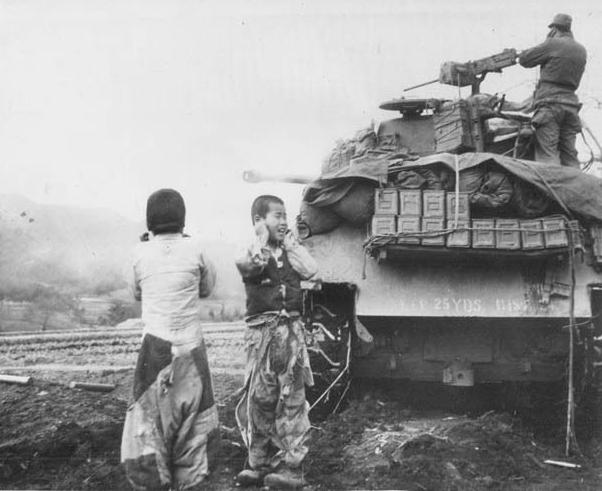
The Korean War: American Forces Stabilize the Front (February-March 1951)

Figure 1.--Tanks were used by both sides inn the Korean War. There were, howver, no large World War II-styled massed tank battles. The Sovierts had given the Northn Korens T-34 tanks, but the South Koreans dfid not have any tabks wheb invded. The rugged terraine and massive amerucan air power precluded this. The press caption here read, "Korean Youth Rinsiders at Grin Fireworks Show: The harrowing exoeriences born of war are commonplace in devastated Korea where civilians fid themselves ringsiders in the grim show. These two Korean boys wandering near the scebne of action can only clasp hands over their ears to muffle the sound as the crew of a M-4 tankm blasts enemy held positions. The youngsters continued on their aimlss journey never very far from the battkeground,. The photograph was dated April 30, 1951."
|
|
Throughout December and January of 1951, US/UN/ROK forces continued retreating (December 1950-January 1951). The Chinese were taking enormous casualties, but for a while it looked like the Chinese would totally defeat the U.N. forces. Months of heavy fighting followed. President Truman announced in a press conference that the United States was contemplating using atomic bombs. America was now throwing massive resources into the struggle. Military expenitures for the Fiscal Year 1952 reached $55 billion, compared to the mere $13 billion spent annually before the Korean War. (These numbers may sound small today, but were massive amounts in the early-1950s.) Ajmerican commander General Walton H. Walker was killed in a car accident (December 23, 1950). Lt. General Matthew Ridgway assumed command of US/UN/ROK ground forces in Korea. Ridgway was hughly regarded by both MacArthur and the American Joint Chiefs of Staff (JCS). The JCS began dealing primarily with Ridgway in Korea than MacArthur in Japan. Ridgway evacuated Seoul and Inchon as the Chinese steadily moved south (January 4, 1951). The United Nations forces with massive air support managed to sabilize the front. As the Chinese moved further south, their supplies became increasingly vulnerable to interdiction through air attack. Americam artillery deployed in force, caused huge casualties in the Chinese human wave attacvks. Ridgway in addition to militarry operations placed considerable emphasis on morale and care for the men fighting the War, something MacArthur as in World War II was prone to neglect and in some cases ignore. Ridgeway worked to get better food to the front for the men and warmer clothing. Ridgway also strov to improve the effectiveness of Mobil Army Surgical Hospitals (MASH). As the Chinese advance slowed, the confidence and morale of U.N. forces bnegan to recover. The Chinese were finally stopped with Operation Thunderbolt, the first important US/UN/ROK offensive since the Chinese intervention. Then Operation Ripper succeeded in taking back Seoul which as now in ruins from the Chinese and pusjhiong back to the 38th parallel (March 1951). From this point, the 38th parallel became the center of the conflict.
CIH

Navigate the Children in History Website:
[Return to Main Korean War page]
[Return to Main specific war and crisis page]
[Return to Main early Cold War period page]
[Return to Main Korean history page]
[Introduction]
[Animals]
[Biographies]
[Chronology]
[Climatology]
[Clothing]
[Disease and Health]
[Economics]
[Ethnicity]
[Geography]
[History]
[Human Nature]
[Law]
[Nationalism]
[Presidents]
[Religion]
[Royalty]
[Science]
[Social Class]
[Bibliographies]
[Contributions]
[FAQs]
[Glossaries]
[Images]
[Links]
[Registration]
[Tools]
[Children in History Home]
Created: 6:12 AM 10/15/2013
Last updated: 6:13 AM 10/15/2013



